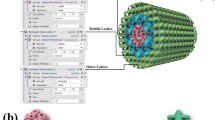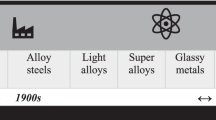Abstract
Some subordinate mechanical properties, such as the strain hardening exponent (n) and the fracture true stress (\(\sigma_{\text{f}}\)), are not available in general material property handbooks, although they are important in choosing materials. This paper investigated the relations between the subordinate mechanical properties to the basic ones for power-law hardening materials. Our semiempirical analysis shows that, in uniaxial tensile experiment, the strain hardening exponent is controlled by the ratio of the yield strength (\(\sigma_{\text{s}}\)) and the ultimate tensile strength (\(\sigma_{\text{b}}\)), and the value also equals to the maximum uniform strain. The absolute calculation errors of n on various metal materials are approximately within ± 0.03. Physically, n expresses the ability of the strength rising from the yield strength to the ultimate tensile strength during uniform deformation; it may also denote the maximum ability of uniform deformation before necking. The fracture strength is controlled directly by n, \(\sigma_{\text{b}}\) and the reduction in area (ψK) in our concise expression. The relative errors of the fracture strength between the calculations and the measurements on metal materials are approximately within 20%. Results also indicate that the fracture true stress represents the increased stress during uniform deformation plus the concentrated stress caused by necking.





Similar content being viewed by others
References
Metals handbook v.1: Properties and selection: irons and steels/prepared under the direction of the ASM Handbook Committee, Metals Park, Ohio: American Society for Metals, 1978.
Handbook Aerospace Structural Metals. Metals and Ceramics Information Center, Battelle Columbus Division, Columbus, Ohio, USA, 1972, 5:13.
N.E. Dowling, Mechanical Behavior of Materials: Engineering Methods for Deformation, Fracture, Prentice Hall, Englewood Cliffs, 1993
P. Antoine, S. Vandeputte, and J.-B. Vogt, Empirical Model Predicting the Value of the Strain-Hardening Exponent of a Ti-IF Steel Grade, Mater. Sci. Eng. A, 2006, 433(1), p 55–63
Mo Defeng, Hu He Guoqiu, Liu Xiaoshan Zhengfei, and Zhang Weihua, Effect of Microstructures on Strain Hardening Exponent Prediction of Cast Aluminum Alloy, Acta Metall. Sin., 2010, 46(2), p 184–188
K. Veera Babu, R. Ganesh Narayanan, and G. Saravana Kumar, An Expert System Based on Artificial Neural Network for Predicting the Tensile Behavior of Tailor Welded Blanks, Expert Syst. Appl., 2009, 36, p 10683–10695
X. Zheng, Local strain range and fatigue crack initiation life, in: IABSE Proc. Fatigue Colloq., 1982, pp. 169–178.
S. T. Standnick and J. D. Morrow, ASTM STP 515, 1972, 229–252.
P.W. Bridgeman, Large Plastic Flow and Fracture, McGraw-Hill Book Company, New York, 1952
H.O. Fuchs and R.I. Stephens, Metal Fatigue in Engineering, Wiley, New York, 1980
Research Institute for Strength of Metals, Special Issue of Metal Material strength, Vol. II, Xi’an Jiaotong University, 1972.
Y.B. Fridman, Mechanical Properties of Metals, Part One: Deformation and Destruction, 1974.
Acknowledgment
We gratefully thank for the financial support from National Science Foundation of China (Grant No. 51206108).
Author information
Authors and Affiliations
Corresponding author
Rights and permissions
About this article
Cite this article
Hu, Y., Hu, ZZ. & Cao, SZ. Semiempirical Formulae for Mechanical Properties Controlled by Strength and Ductility of Power-Law Hardening Metallic Materials. J. of Materi Eng and Perform 27, 6149–6154 (2018). https://doi.org/10.1007/s11665-018-3636-8
Received:
Revised:
Published:
Issue Date:
DOI: https://doi.org/10.1007/s11665-018-3636-8




